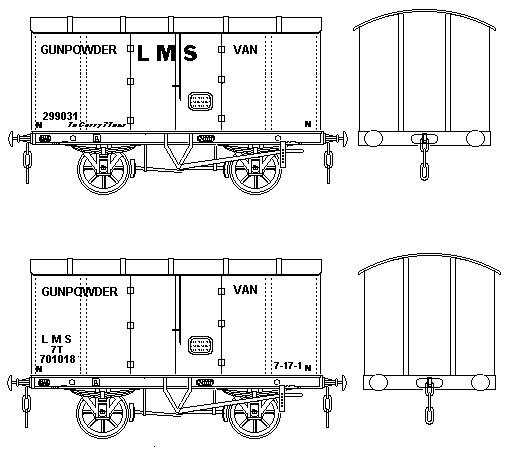
| Return to index page |
London Midland & Scottish Railway
The LMS reputedly delayed the repainting of absorbed stock rather longer than most other companies, example of pre-grouping liveries were still seen in traffic into the 1930's.
The basic 'freight' body colour adopted in 1923 was a grey rather similar to that used by the Midland Railway, one of the larger constituent companies. This grey however was subject to wide variation and was generally slightly darker than the old Midland colour. Van roofs were painted white, later aluminium, but in both cases they rapidly became an ever darkening grey in service. The underframe was generally black, but there were example of the solebars being painted in body colour in later years.
The LMS added numbers to the beginning of the grouped wagon and van numbers, making them 6 figure numbers, these were generally to the lower left of the body, except on vans with sliding doors where they appeared on the door itself.
On vans and goods wagons the letters LMS were painted on in a size to suit the available space, the largest being 18 inches (46 cm). Some wagons had specific roles and were marked by painting either a code word or a description of the specified load on the left hand end of the solebar in letters 2 inches (5 cm) high, although not common prior to 1936. Specialised vans had, for example, INSULATED painted centrally on the door(s).
Vacuum fitted stock was initially painted with a large letter X, generally towards the lower right of the body side, or on the right of the door on sliding door vans, just above the number, this was a continuation of Midland Railway practice.
Non Common User stock was marked with a 4 inch (10 cm) high letter N in the bottom corners of the body after about 1926.
Permanent Way stock was marked with the letter E, about 15 inches (38 cm) high towards the left end of the sides.
On end-door mineral wagons the LMS initially continued the Midland Railway practice of painting a single white vertical stripe at the end fitted with the door, by the early 30's this changed to a diagonal stripe 4 inches (10 cm) wide running from the bottom corner of the side at the fixed end to the upper corner of the side at the opening end.
Gunpowder vans on the LMS were painted in standard freight stock grey or bauxite livery, the layout for the earlier forms is shown in the sketches appended to this section.
Closed containers were painted coaching stock `Lake' (a deep red colour) with black ironwork and yellow lettering, the Peco offering dates from 1932. In about 1935 by a layout similar to that applied to the Peco GWR container was adopted by all the Big-Four for the furniture removals BK types, the basic company colours remaining the same. Refrigerated containers were white, with black ironwork and lettering. Some earlier examples have a black roof. Open containers were painted grey and subsequently bauxite with white lettering. The ironwork on these was sometimes picked out in black, unlike the standard wagon livery.
The gas holder trucks, used to supply gas for kitchen cars etc. are believed to have been painted in coaching stock colours, lake with white lettering in at least one example.
In 1936 there was a change to lettering policy, introducing a smaller LMS generally painted towards the lower left corner, five inches (13 cm) high. The diagonal line on end door mineral wagons became a stripe running from the bottom of the side door nearest the end door to the top of the end door, following the line of the diagonal strapping, a style later adopted by British Railways. Bottom doors were marked with the open V painted on the side as already described.
Also in 1936 the body colour was changed to Bauxite, a reddish brown, however some wagons had already received the new lettering style on a grey body, hence one may introduce some variation into ones stock in this way. The Graham Farish 7 plank open is incorrectly liveried having the bauxite body but the larger LMS painted on the sides.
As mentioned above the LMS, in conjunction with the other companies, standardised their lettering beginning in 1937. This did not replace the older liveries overnight however, and the Peco container and large lettered wagons are suitable for the period up to the Second World War. With the war a simplified container livery of plain bauxite with small white lettering was introduced.
Gunpowder vans were painted in standard freight colours, the side markings followed the above sequence of changes
Road vehicles, lorries and vans, were painted maroon with white lettering.
Fig ___ LMS Gunpowder vans 
Fig ___ Pre-1937 LMS Liveries 
Fig ___ Post 1937 LMS Liveries 
Fig ___ LMS open container liveries 
Fig ___ LMS closed container liveries 